Role (Group of 4)
Background
Challenge
Boiler Gold Rush (BGR) takes place the week before fall classes begin, and Purdue encourages all incoming students to take part. You’ll learn about campus traditions, Purdue culture and University resources. It’s also a great chance to make lasting friendships and learn how to be a successful Boilermaker. We were asked to create a comprehensive system that increases the enjoyment and confidence of first year students at Purdue. The solution needed to be able to be launched in association with Boiler Gold Rush, but not a replacement for it. While creating our solution we were asked to take numerous needs across campus into consideration. The end solution should find a way to keep the first-year student at Purdue University engaged excited while also helping them to build deeper habits that will increase success in their college career.
Problem
Incoming Domestic Students at Purdue University who attend BGR, are experiencing overwhelming anxiety caused by their unfamiliarity with their new surroundings and BGR does not provide them with the proper knowledge to navigate academic campus.
Solution
We decided to focus on reducing anxiety and increasing the confidence of incoming domestic freshmen students during Purdue’s Boiler Gold Rush by familiarizing students with academic campus. In order for our solution to work, our target user has to be incoming domestic freshmen students because our primary and secondary research was focused on information and statistics of domestic students’ experiences during BGR rather than international BGR students.
Based on this research we found, the main anxiety of incoming domestic students lies within being unfamiliar and unable to navigate campus, more specifically being unable to find the buildings their classes are located in.
Finally, we decided to create an additional product to the Purdue App, which is called an “Immersive” Map. The map will allow admitted students to take a virtual tour prior to arriving to campus. Upon arrival, admitted students will gain access to a navigational feature of the immersive map that will allow them to receive directions to any on campus location and walk through their class schedule in their free time.
Research
Observations
To aid in our research we decided to perform observations of people who are visiting campus to gain better knowledge about how people navigate around Purdue when they are unfamiliar with it. Our findings are the following:
- Incoming freshmen are unaware of the difference between residential (south) and academic (north) campus.
- Because of the large size of campus incoming freshmen are overwhelmed and still get lost even with directional aids.
- Tours don’t cover the full span of campus, incoming freshmen don’t get the full experience
- Incoming freshmen are reluctant to ask for directions
- Smartphone directions don’t always take you to the correct place when walking
- Unaware of shortcutInterviews
For our interviews we reached out to four domestic students that participated in BGR to understand their experience. To gain insight about what problem we should focus on, we continued our research with interviews of students who have successfully completed Purdue’s Boiler Gold Rush.
Who Did We Interview?
- A few Purdue Domestic Students who participated in BGR
- One Purdue Student who participated in BGR and now works as a Team Leader
Insight
User Behavior
We noted that although all four of our interviewees signed up for and attended BGR, none of them participated fully in every event. Only one student said that they still talked to and interacted with members of their BGR group. We also found that students often skipped out on the early morning activities such as breakfast because they were “too early to wake up for” and some skipped the Academic Success Sessions because they were not engaging and interactive enough.
The main concern we found from our interviews was that 3 out of 4 interviewees claimed that they were nervous coming to Purdue’s campus and hoped that BGR would help with navigation and finding their classes.
All three of these students expressed that BGR failed to do this and two of them said that their anxiety would have been lessened during the first week of classes if they knew where they were going.
Affinity Diagram
We decided to create an affinity diagram in order to organize the large amounts of information that we gathered from our own personal experiences and user interviews. The affinity diagram helped us narrow down the issue we wanted to focus on because the issue seemed to be too large and complex to grasp. We put the results we gathered about experiences at BGR onto separate post-it notes on a white board.


Next, we analyzed the post-its and found relationships between them, creating subgroups. These subgroups we later labeled, “Anxieties”, “Negative Experiences”, “Aspects of BGR”, “Demographics”, and “Participation”. This allowed us to find our focus on the anxieties and negative aspects of BGR and ensure our solution solves these issues, specifically the problem of the size of campus and the fact that many people do not know how to find their classes.
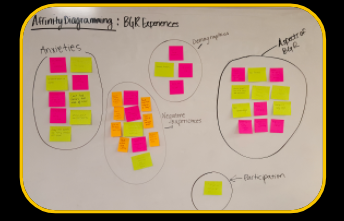
Initial Sketches

After analysis of our secondary and primary research, we decided to sketch solutions to lessen the anxiety of navigation around campus. We agreed than an interactive navigational program would be the most effective way to solve our problem. The following slides will showcase our initial prototype.
Low-fi Prototype
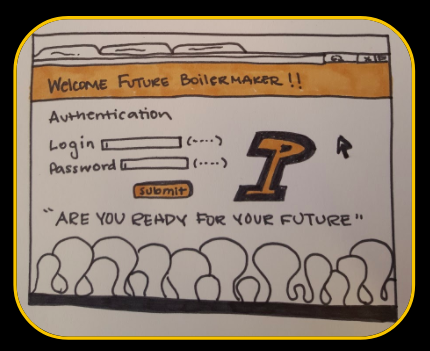 This page is the initial page that will start the user’s journey through the website. This page will require the user to enter there MyPurdue login information in order to access the rest of the website.
This page is the initial page that will start the user’s journey through the website. This page will require the user to enter there MyPurdue login information in order to access the rest of the website.
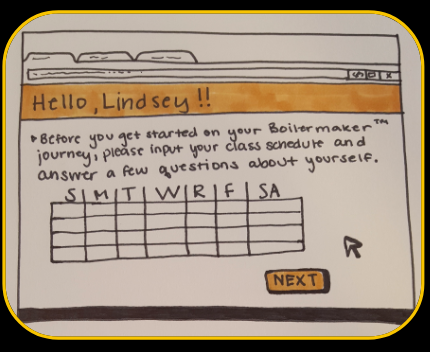
After the user logs into the site, this page will appear. The user will be prompted to input their class schedule so that the interactive map can be personalized to the specific student. The schedule will allow for the interactive map to highlight the few buildings that the student will be going to frequently, instead of having all of Purdue’s buildings highlighted, which we have found to be overwhelming.
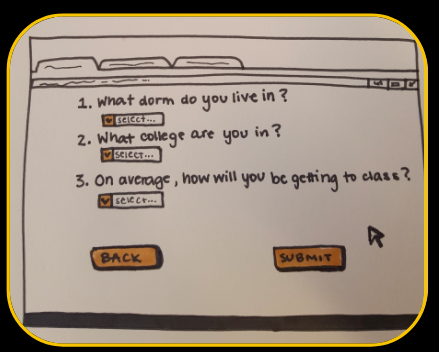
Once the user inputs their schedule, they are prompted to answer a few questions about themselves in order to create the ideal map. Under each question is a drop down menu of options. The website will use the dorm information to find directions from the user’s dorm to their classes.
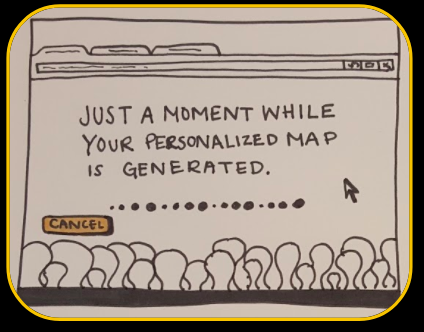
Next, the map will be generated and this screen will appear while the user waits to see his/her own personalized map
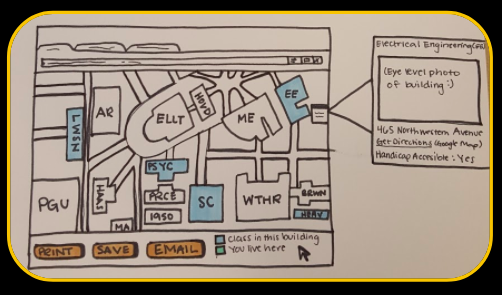
When the map is generated, this screen will appear. The buildings in which the user has a class in will be highlighted in blue and the building the user lives in will be highlighted in green. The user will be able to print, save, or email the map to themselves. The option to email allows the user to use the map on a mobile device. When a building is clicked on, a popup will appear with the name of the building, a photo, address and ability to get directions.

This is the final page. The user will be able to return to the map, return to the homepage, or logout from this page.
Feedback & Iteration
Group Critique
During this group critique we showed the class our initial prototype and received the really helpful feedback below that helped us to drive our redesign in the right direction:
- There is no need to create a website that will require students to input information to which the school already has access.
- Focus more on improving the Purdue Map Application than the logistics of the interface
- Less emphasis on students who don’t have smartphones because they are a minority
- Focus on how the student will feel using our solution
- Think about solving for different stages of student interaction with campus (before arrival to BGR/During BGR/After BGR)
Based on this feedback we were able to construct a redesign that we feel more accurately fits our user.
Usability Testing
After ideation and sketching, we tested our low-fidelity with four college students. The goal is to see if any part of the our prototype may cause confusion to the users. A few issues we noted during testing:
- Liked increased detail on Purdue map.
- Commented on added detail of aerial view map.
- Liked being able to see directions from first person.
Iteration
After receving feedback from potential users and our peers after the group critique, we gathered as a team and discussed where we wanted to move forward.
Below are some of the alternatives we came up with.
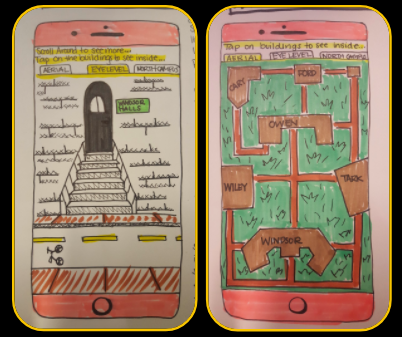
Before coming to campus for BGR freshman will be prompted to download and log in to the Purdue app from their New Student Checklist. Everything in the app will remain the same except for the map feature that is currently being used. It will be replaced with our reimagined “immersive” map.
Features:
- Allows students to explore both North (Academic) and South (Recreational) campus in a virtual reality setting.
- There are aerial and eye-level views and students may scroll around to see more buildings.
- Tapping on any particular building allows the student to see inside (the “scroll for more” feature works inside as well)
- An exit button is available once inside a building
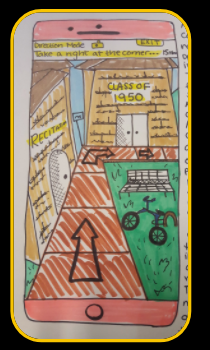
Once a student arrives to campus for BGR, they will be granted the opportunity to switch from the VR map to a version that allows them receive campus directions during and after BGR.
Features:
- Accessible through the Purdue app map and will use the current google API & a smartphone’s camera to give accurate directions to any on campus destination.
- As the students uses their smartphone’s camera to scan their surroundings, arrows will pop up to keep them headed in the right direction and eliminate the confusion that the current map creates.
- During anytime that students are receiving directions, they have the option to exit
- Because this design is geared towards students who are unfamiliar with campus there is an option for students with advanced knowledge about campus to use the currently implemented map to save time.
Conclusion
Overall the modification to the Purdue App and implementation to BGR proved to be simple, easy to learn and would be successful in making incoming freshman less anxious about navigating around campus prior to the start of the semester. By having the user familiarize themselves with campus before and during BGR, the main anxiety that we found was associated with BGR, will be addressed.